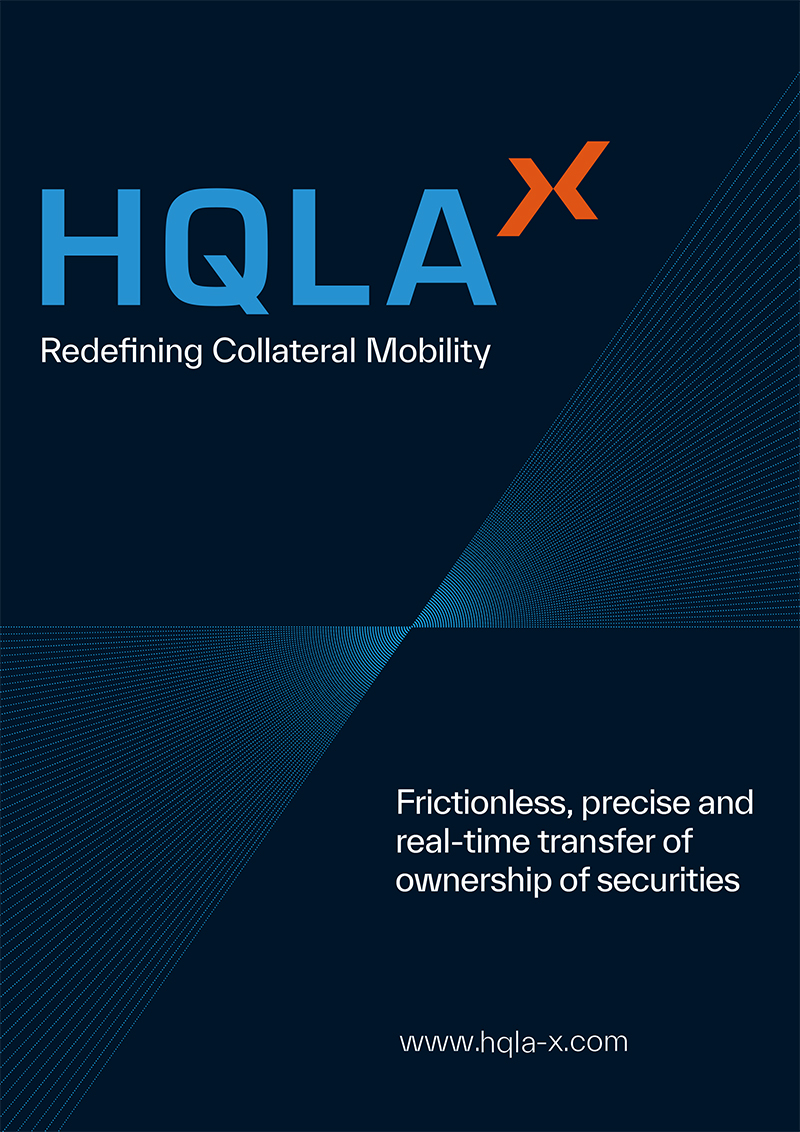What do Web3 and the metaverse have to do with collateral management?
11 October 2022
Collateral management and securities finance are not going full web3 just yet, but the train is gathering momentum explains Ted Allen, business development director for FIS Securities Finance and Collateral
 Image: Ted Allen
Image: Ted Allen
The past few years in collateral management have been somewhat transformative. Economic and regulatory imperatives have finally driven the bulk of the market to bring together collateral management and optimisation across OTC and listed derivatives with securities lending and repo. Utilities like Acadia, TriResolve and the ever-growing use of triparty have removed much of the legwork that previously dogged the market. The common domain model will further reduce the amount of post-trade disputes and settlement fails.
The goals have been efficiency gains and cost reduction in which assets are deployed as collateral, minimising balance sheet use and streamlining operations. At FIS, we have long promoted this approach; we brought together our previously fragmented securities lending, repo and cross-product collateral platforms into a single stack and combined it with the technology efficiencies of a cloud native platform. With much of that work complete, attention has now turned to the next big thing. So what do Web3 and the metaverse have to do with collateral management?
Let’s start by defining what we mean by Web3 and the metaverse. Web3 is a term used to describe the current evolution of internet use. Web1 refers to the web in its original form where large audiences looked at static pages created by a relatively small number of content creators. Web2 saw the growth of interactivity through user-generated content via social media and other communities. It is a much more interactive environment, but dominated by a few big players. Web3 promises a revolution in the definition of ownership through distributed ledgers or blockchains. In a simple example, contrast Web2 Facebook with a social media platform owned by its users where advertising revenue goes to the users based on their participation. Despite some questionable, ultra-libertarian idealism underpinning some aspects, Web3 projects are starting to take off.
The metaverse generally refers to persistent, immersive, virtual environments built on Web3 technologies that have their own economies. Here people interact with each other and can buy and sell items. The gaming industry is at the cutting edge of this with its multi-player online games and an evolution may be to make items bought on one game portable to another. This concept is applicable across industries. Blockchains, smart contracts, tokens and cryptocurrencies provide the technical, financial and legal infrastructure behind the metaverse and are applicable whatever the domain.
At our annual FIS Emerald client event earlier this year, we launched a metastore allowing attendees to get hands-on experience with transactions in the metaverse, creating the bridge from physical to digital which includes working with cryptocurrency exchanges and all forms of money movement technology to enable shopping and other transactions. Attendees could purchase both physical items and limited edition non-fungible tokens (NFTs) at the metastore, all powered by FIS solutions.
Decentralised finance
An often-cited benefit of the metaverse is the enablement of decentralised finance, the DeFi model. This contrasts with the traditional finance model where marketplaces or brokers bring buyers and sellers together, but where the post-trade settlement and record keeping are separate. In DeFi, this all happens through the technology in one place and there is no neutral settlement or record-keeping authority to guarantee the change in ownership. Decentralised exchanges are created and instead of a broker or trading venue bringing buyers and sellers together, it is all managed on decentralised applications or dApps. The dApp enables price discovery through algorithms and allows the buyers and sellers to interact directly with each other without need for an intermediary. The trade is agreed and settled end-to-end through smart contracts on a blockchain. The blockchain itself then is a single, immutable golden source of the records.
A further interesting aspect of the DeFi model is the concept of staking. This incentivises users to put their assets into the platform to create liquidity. Stakers are rewarded with more of the tokens that they stake or special tokens native to the decentralised exchange creating yield or value they can reinvest. This has ballooned for cryptocurrencies into a very fast-growing market and, despite this year’s crypto winter, all the major banks have crypto initiatives ongoing. They typically start out with custody, expand to trading and then on to staking.
Crypto lending through DeFi has similar drivers to the securities lending market. Borrowers seek access to the crypto currencies because they have a directional view on the price of the crypto asset or to exploit arbitrage opportunities from price differentials either between exchanges or between crypto spot and futures prices. Lenders see opportunities for yield from the fees on the loans. The trades are structured typically as a crypto versus crypto or versus a stablecoin (which these days should be backed by sufficient liquid traditional assets, i.e. fiat cash or HQLA, such that it retains its peg to a fiat currency under changing interest rates and crypto market conditions).
Alternatively, the crypto currency is used as collateral for a fiat loan in much the same way margin lending works with traditional securities. The difference in the crypto lending models is the size of the haircuts needed to account for the price volatility, the frequency of margin calls and automatic liquidation provisions of the loans in the event of a decline in the value of the crypto collateral to a trigger loan-to-value (LTV) level. We have recently brought an FIS solution to market to manage the collateralisation of these types of crypto-collateralised loans alongside traditional lending activity. This is a business that is still troublesome for traditional, regulated banks to engage in, however, given evolving regulations, particularly in the US, UK and Europe, and the prohibitive capital charges on digital assets proposed by the Bank of International Settlements (BIS) in its latest consultation paper.
‘TradFi’ world
Whatever your view on crypto, there are some aspects of the model that are beginning to show value in different aspects of the financial industry. Which brings us to the ‘TradFi’ world of securities finance and collateral. We already see start-up blockchain solutions from HQLAX, J.P. Morgan, SWIAT and others where participants can lend, borrow, repo or use as collateral tokenised holdings of traditional bonds and equities. A holding of a traditional security, or indeed cash, is locked up at the custodian and a token representing ownership of those securities is created. These tokens can be transferred between participants in the ecosystem.
These are private, permissioned blockchains where participants are vetted and counterparties are known and not the open, public blockchains in the DeFi crypto world. That is essential in this market because the free-for-all, disintermediated DeFi crypto world comes up against some hefty regulatory roadblocks in securities finance and the intermediaries are performing useful governance functions that cannot be left to smart contracts. The potential gains from these models are cost reductions and settlement certainty because the underlying real-world securities don’t move. Time-based, intraday settlement has the potential to reduce borrowing costs and lower funding and capital costs. The golden source of trade and settlement information should remove much of the unnecessary post trade baggage of reconciliations and settlement fails that drive costs and higher barriers to entry.
As these ecosystems develop and gain traction in the market, interoperability between them will become more pressing. The problem of moving tokenised assets from one blockchain environment to another has not yet been solved (it also hasn’t for gaming) but there are initiatives on the way.
What is clear is that blockchains, tokenised assets and smart contracts promise much for the collateral management industry even if we will not see crypto used as collateral in these markets anytime soon. It will be a gradual journey of adoption of tokenised traditional equities and bonds and then digital native securities. Digital assets and traditional assets will exist alongside each other and share infrastructure for some time to come and that is the approach we at FIS are taking with our platforms. Collateral management and securities finance are not going full web3 just yet, but the train is rolling down that track.
The goals have been efficiency gains and cost reduction in which assets are deployed as collateral, minimising balance sheet use and streamlining operations. At FIS, we have long promoted this approach; we brought together our previously fragmented securities lending, repo and cross-product collateral platforms into a single stack and combined it with the technology efficiencies of a cloud native platform. With much of that work complete, attention has now turned to the next big thing. So what do Web3 and the metaverse have to do with collateral management?
Let’s start by defining what we mean by Web3 and the metaverse. Web3 is a term used to describe the current evolution of internet use. Web1 refers to the web in its original form where large audiences looked at static pages created by a relatively small number of content creators. Web2 saw the growth of interactivity through user-generated content via social media and other communities. It is a much more interactive environment, but dominated by a few big players. Web3 promises a revolution in the definition of ownership through distributed ledgers or blockchains. In a simple example, contrast Web2 Facebook with a social media platform owned by its users where advertising revenue goes to the users based on their participation. Despite some questionable, ultra-libertarian idealism underpinning some aspects, Web3 projects are starting to take off.
The metaverse generally refers to persistent, immersive, virtual environments built on Web3 technologies that have their own economies. Here people interact with each other and can buy and sell items. The gaming industry is at the cutting edge of this with its multi-player online games and an evolution may be to make items bought on one game portable to another. This concept is applicable across industries. Blockchains, smart contracts, tokens and cryptocurrencies provide the technical, financial and legal infrastructure behind the metaverse and are applicable whatever the domain.
At our annual FIS Emerald client event earlier this year, we launched a metastore allowing attendees to get hands-on experience with transactions in the metaverse, creating the bridge from physical to digital which includes working with cryptocurrency exchanges and all forms of money movement technology to enable shopping and other transactions. Attendees could purchase both physical items and limited edition non-fungible tokens (NFTs) at the metastore, all powered by FIS solutions.
Decentralised finance
An often-cited benefit of the metaverse is the enablement of decentralised finance, the DeFi model. This contrasts with the traditional finance model where marketplaces or brokers bring buyers and sellers together, but where the post-trade settlement and record keeping are separate. In DeFi, this all happens through the technology in one place and there is no neutral settlement or record-keeping authority to guarantee the change in ownership. Decentralised exchanges are created and instead of a broker or trading venue bringing buyers and sellers together, it is all managed on decentralised applications or dApps. The dApp enables price discovery through algorithms and allows the buyers and sellers to interact directly with each other without need for an intermediary. The trade is agreed and settled end-to-end through smart contracts on a blockchain. The blockchain itself then is a single, immutable golden source of the records.
A further interesting aspect of the DeFi model is the concept of staking. This incentivises users to put their assets into the platform to create liquidity. Stakers are rewarded with more of the tokens that they stake or special tokens native to the decentralised exchange creating yield or value they can reinvest. This has ballooned for cryptocurrencies into a very fast-growing market and, despite this year’s crypto winter, all the major banks have crypto initiatives ongoing. They typically start out with custody, expand to trading and then on to staking.
Crypto lending through DeFi has similar drivers to the securities lending market. Borrowers seek access to the crypto currencies because they have a directional view on the price of the crypto asset or to exploit arbitrage opportunities from price differentials either between exchanges or between crypto spot and futures prices. Lenders see opportunities for yield from the fees on the loans. The trades are structured typically as a crypto versus crypto or versus a stablecoin (which these days should be backed by sufficient liquid traditional assets, i.e. fiat cash or HQLA, such that it retains its peg to a fiat currency under changing interest rates and crypto market conditions).
Alternatively, the crypto currency is used as collateral for a fiat loan in much the same way margin lending works with traditional securities. The difference in the crypto lending models is the size of the haircuts needed to account for the price volatility, the frequency of margin calls and automatic liquidation provisions of the loans in the event of a decline in the value of the crypto collateral to a trigger loan-to-value (LTV) level. We have recently brought an FIS solution to market to manage the collateralisation of these types of crypto-collateralised loans alongside traditional lending activity. This is a business that is still troublesome for traditional, regulated banks to engage in, however, given evolving regulations, particularly in the US, UK and Europe, and the prohibitive capital charges on digital assets proposed by the Bank of International Settlements (BIS) in its latest consultation paper.
‘TradFi’ world
Whatever your view on crypto, there are some aspects of the model that are beginning to show value in different aspects of the financial industry. Which brings us to the ‘TradFi’ world of securities finance and collateral. We already see start-up blockchain solutions from HQLAX, J.P. Morgan, SWIAT and others where participants can lend, borrow, repo or use as collateral tokenised holdings of traditional bonds and equities. A holding of a traditional security, or indeed cash, is locked up at the custodian and a token representing ownership of those securities is created. These tokens can be transferred between participants in the ecosystem.
These are private, permissioned blockchains where participants are vetted and counterparties are known and not the open, public blockchains in the DeFi crypto world. That is essential in this market because the free-for-all, disintermediated DeFi crypto world comes up against some hefty regulatory roadblocks in securities finance and the intermediaries are performing useful governance functions that cannot be left to smart contracts. The potential gains from these models are cost reductions and settlement certainty because the underlying real-world securities don’t move. Time-based, intraday settlement has the potential to reduce borrowing costs and lower funding and capital costs. The golden source of trade and settlement information should remove much of the unnecessary post trade baggage of reconciliations and settlement fails that drive costs and higher barriers to entry.
As these ecosystems develop and gain traction in the market, interoperability between them will become more pressing. The problem of moving tokenised assets from one blockchain environment to another has not yet been solved (it also hasn’t for gaming) but there are initiatives on the way.
What is clear is that blockchains, tokenised assets and smart contracts promise much for the collateral management industry even if we will not see crypto used as collateral in these markets anytime soon. It will be a gradual journey of adoption of tokenised traditional equities and bonds and then digital native securities. Digital assets and traditional assets will exist alongside each other and share infrastructure for some time to come and that is the approach we at FIS are taking with our platforms. Collateral management and securities finance are not going full web3 just yet, but the train is rolling down that track.
NO FEE, NO RISK
100% ON RETURNS If you invest in only one securities finance news source this year, make sure it is your free subscription to Securities Finance Times
100% ON RETURNS If you invest in only one securities finance news source this year, make sure it is your free subscription to Securities Finance Times



